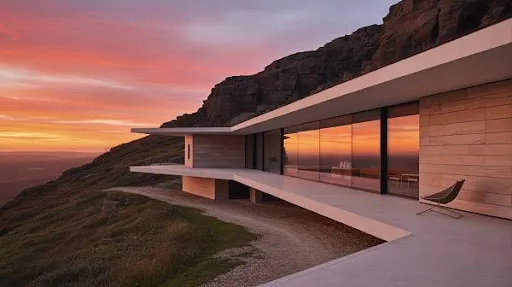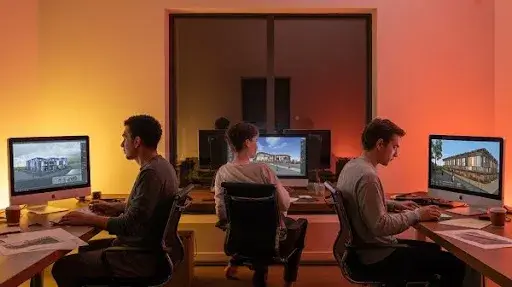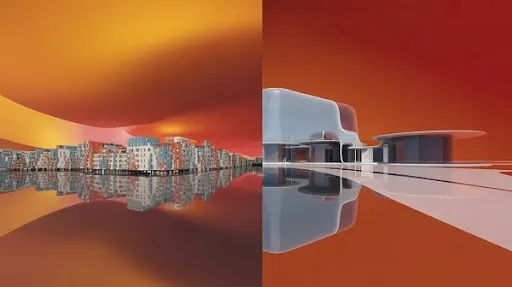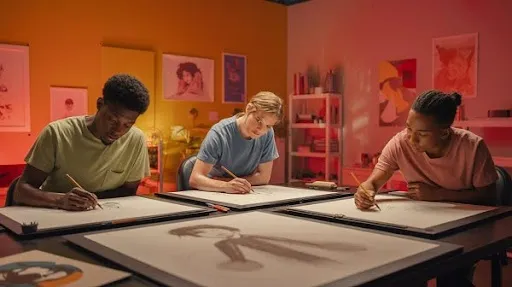Some things are easy to say on paper; understanding how they feel is different. A floor plan gives dimensions. It rarely tells you if a living room will feel cramped, or if a window will catch the evening light just right. People want to know how a place will behave, and fast. That need is one big reason architectural visualization has become part of everyday design work.
This practice converts sketches and plans into realistic 3D visualizations that look like photos but are still open to change. Developers show them to buyers. Designers test materials with them. City teams use them to preview whole neighborhoods. The result: fewer surprises once the first brick is laid.
So, what is architectural visualization in plain terms, and who’s actually using it?
What is Architectural Visualization?
What is architectural visualization? Put simply, it’s the process of making a design come across as real before it’s built. A 3D visualization artist uses modeling software, textures, lighting setups, and camera framing to create images or short videos that communicate how a space will look and feel.
This goes beyond showing walls and roofs. Good visualization includes furniture, people, landscaping, even that weird shadow a tree casts in the afternoon. The goal isn’t trickery. It’s clarity. Stakeholders should be able to answer practical questions after viewing a render: Will this room feel warm? Is the plaza usable at sunset? Do the materials speak to the brand?
Architectural visualization works for single rooms, whole buildings, and large masterplans. It’s flexible and, when done well, fast enough to be part of the design conversation, not an afterthought.
Fact: The Architectural visualization market is expected to grow to a value of $205 billion by 2033.
Who Uses Architectural Visualization?
This tool sits at the crossroads of design, marketing, and planning. Different people use it in different ways:
Architects and Builders
They spot clashes in the plan, test sightlines, and approve material choices early on.
Developers and Real Estate Teams
They show potential buyers what’s coming, and often sell units before construction begins.
Interior Designers
They test fabrics, furniture layouts, and lighting scenes without shifting actual pieces.
Marketing and Sales
Teams hire 3D animation services to make promotional videos and online content that convert.
Film, TV, and Gaming
These industries borrow the same techniques to build believable sets and environments.
City Planners
They preview transport corridors, parks, and new districts at scale, helping decision-makers see the impact.
Short note: each group uses visualization for a slightly different aim, but they all want the same thing, clearer choices, sooner.
Architectural Visualization Processes (step-by-step)
When someone asks about architectural visualization processes, they usually mean the typical flow from sketches to finished image. Here’s a straightforward breakdown:
Concept and Input
Everything starts with what already exists: sketches, CAD files, site photos. These become the blueprint for the model.
3D Modeling
A visualization artist specializing in architectural visualization builds the geometry: walls, windows, roofs, and key furniture. This is the skeleton.
Materials and Textures
Surfaces are layered with detail. Wood grain, tile grout, fabric weave, these small things sell realism.
Lighting and Atmosphere
Lighting sets the mood. Artists test different times of day and artificial light rigs to find the scene that best communicates design intent.
Rendering
This is the computer work: producing final stills or animations. Depending on complexity, renders might be quick previews or very high-resolution output.
Post-production
Color correction, compositing people or trees, and small fixes happen here. The goal is polish, not alteration of core design.
That’s the typical route. Projects sometimes skip steps or loop back; the process is iterative by nature.
The Benefits of Architectural Visualization
People often ask: what are the real benefits of architectural visualization? Here are the practical ones that matter on a project:
- Catch problems early. A misplaced stair or awkward corridor becomes obvious in a render, saving big on-site fixes.
- Save time and money. Digital mock-ups reduce the need for physical models, trial builds, or repeated site visits.
- Sell with confidence. Prospective clients respond to visuals, they make decisions faster.
- Communicate more clearly. Non-technical clients don’t read blueprints well; they do understand images.
- Try options fast. Swap a countertop, test a different tile, compare two lighting setups with minimal fuss.
These outcomes are why many teams now include visualization in early design meetings rather than as a final touch.
Types of Architectural Visualization
Different goals call for different tools. Here are the common forms you’ll see on real projects:
2D Drawings and Plans
Still necessary for construction, but limited when you want to convey atmosphere.
3D Modeling
The foundational step that lets you move into richer visuals.
Interior Rendering
Focuses on rooms: finishes, furniture, and human scale.
Exterior Rendering
Shows facades, landscaping, and how a building sits in its context.
Virtual Reality (VR)
Immersive walkthroughs via a headset. Great for scale and spatial feel.
Augmented Reality (AR)
Overlays a proposed design onto an existing view (phone or tablet). Handy on site.
Often, teams mix several of these for a full presentation. Simple renders for approval. High-end visuals for sales. VR for big-ticket stakeholders.
The Role of a 3D Visualization Artist
Behind the final picture is a person making dozens of judgment calls. A 3D visualization artist combines taste (what angle feels honest?) with technique (how do shadows behave?). They choose framing, place props, and balance realism with clarity.
In small studios, one person may do it all. In larger teams, people specialize: modelers, texture artists, lighting artists, and post-production editors.
Good artists don’t hide flaws. They show what matters, so teams can judge design, not be distracted by noise.
A Brief History of Architectural Visualization
People have always tried to show the future. Centuries ago, builders used clay models and painted perspectives to explain ideas that didn’t exist yet. Those early tools helped people imagine size, proportion, and the feel of a space.
Then came technical drawing. Lines got cleaner. Measurements became precise. But most viewers still had to translate symbols into mental images. Computers changed that. Over the last fifty years, software for modeling and rendering turned rough concepts into images that look very close to real life.
That shift mattered. It moved visualization from something a few firms did to something most teams expect. Now, a 3D visualization artist can show how a material will age, how light behaves through a season, or how a plaza feels at dusk, all before the ground is broken. That ability reduced guesswork and made design choices easier to defend.
Why 3D Renderings Change the Conversation
A good image short-circuits confusion. Instead of explaining line types and hatch marks, you show a picture. People understand it instantly.
The practical wins are straightforward. One big benefit of architectural visualization is catching costly errors early. If a stair seems too steep in a render, it’s changed in the model, not on-site where fixes are expensive.
Marketing teams like visuals because they pull people in. A render can make a buyer pause and imagine life in a space. That’s the reason developers pay for strong imagery during pre-sales.
Design teams also win. Renders let people test light, materials, and circulation quickly. So instead of arguing over options, teams try them and pick what works. That keeps projects moving.
Where Visualization Actually Helps (Short Examples)
Real Estate Sales
A set of interior renders helps buyers decide faster. When they can see a kitchen or a balcony in context, uncertainty drops and sales speed up.
Urban Planning
Aerial renders give councils a quick grasp of scale and connection. People see new streets and parks in context and give feedback that’s focused and useful.
Interior Fit-outs
Designers trial materials and layouts without moving furniture. The client picks an option in a meeting, not after weeks of back-and-forth.
Presentations and Approvals
Clear images reduce the usual translation work in stakeholder meetings. No one needs to ‘read’ a drawing if they can look at a render and say, “That’s the one.”
Small, Real Stories That Prove the Point
One small developer tested three kitchen layouts with simple renders. Buyers chose the version that kept sightlines open. That choice became the standard layout across the development, and the renders doubled as marketing assets.
A neighborhood council used an aerial render to preview a proposed square. Before the image, comments were vague. After it, feedback focused on benches and shade, things planners could actually act on.
These examples aren’t dramatic. They’re practical: good visuals lead to faster, clearer decisions.
What’s Next: The Tools and Trends to Watch
The technology keeps improving. Render times that once took days are now measured in hours. Textures and lighting behave more realistically. That’s useful, but the real change is accessibility. VR kits and AR tools cost less than before, so teams can offer immersive previews without a huge budget.
More studios now offer 3D animation services. Instead of a still image, clients get a short walkthrough, a camera moving through a lobby, or a shot across a terrace at sunset. Motion shows sequence and use: where people gather, how light changes, how a space flows.
AI is also starting to help with repetitive tasks. It can suggest material matches or speed up texture work. Still, the core job of a visualization artist, making judgment calls about framing and mood, remains human work. Tools speed the craft; they don’t replace taste.
Frequently Asked Questions
How is a render different from a 3D model?
A 3D model is the raw structure. A render adds texture, light, and context so the model reads like a photo rather than a wireframe.
Will visuals replace construction drawings?
No. Construction needs precise drawings and specs. Renders help decision-making and marketing, but they don’t replace technical documentation.
How long does a typical project take?
Simple concept images can be quick, in a day or two. Highly detailed photoreal renders or animations may take several days, depending on the scope.
Who usually makes these visuals?
Some architects do it in-house. Many firms hire a visualization artist or a studio specializing in architectural visualization for polished results.
Can renders show accurate light and material behavior?
Yes. Skilled artists use measured textures and lighting setups to simulate real-world behavior with fine accuracy.
Final Words
If you want fewer surprises on site and clearer conversations with clients or stakeholders, architectural visualization does that job. It speeds approvals, improves marketing, and saves rework.
At Prolific Studio, one of the best animation studios in Miami, we build realistic 3D visualizations that help teams decide faster and sell smarter. We work with architects, developers, and designers to turn plans into images that people actually understand.
If you want to see how a few well-made renders can change the course of a project, send us a short brief. We’ll show what good visuals do, in practice, not just in theory.










